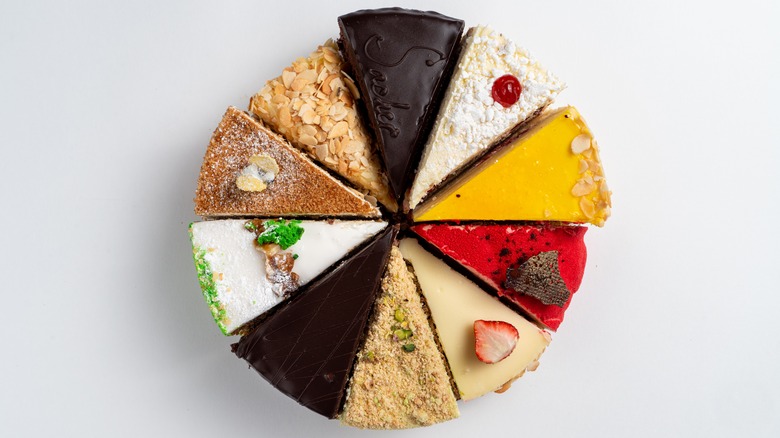Tart Vs. Torte: What's The Difference?
Tortes and tarts, tarts and tortes: what's the difference? Are the words interchangeable, or do they refer to different desserts? Are tarts and tortes both kinds of cakes, or are they more closely related to pies? As The Spruce Eats writes, the distinctions can be a little confusing, and if you're looking for a precise definition, you will be disappointed. However, while the definitions of "torte" and "tart" are murky, the terms generally refer to markedly different kinds of confection. And while both have similarities to other desserts, like cakes and pies, they tend to have specific features that set them apart.
To understand the distinctions between tortes, tarts, cakes, and pies, it's helpful to have a little background information on the ingredients, techniques, and cultural histories behind the confections. That's why we want you to read on to learn more about the origins of tarts and tortes and how to differentiate them.
What is a torte?
Although the word torte essentially translates to "cake," Food52 explains that some common themes among tortes tend to separate them from other cakes. Additionally, there's a cultural aspect: Tortes tend to originate in Europe, whereas many of the desserts Americans call "cakes" originated in the U.S.
According to Brittanica, tortes often include nuts, fruit, and chocolate. Food52 notes that in contrast to lighter, fluffier cakes served in American bakeries, many tortes have a rich, dense texture. While American cakes often use chemical leaveners like baking powder or baking soda, tortes typically rely on eggs as a leavening agent. This eggy texture, combined with the fact that many tortes use alternatives like ground nuts or breadcrumbs in lieu of flowers, contributes to the dense nature of the desert.
Many tortes — like the Dobos torte, which traditionally boasts nine layers of sponge cake — are layered. Others, like the Linzer torte and the Esterhazy torte, made of layers of buttercream and meringue, aren't exactly cakes. However, they are typically tied together by their shared European heritage.
What is a tart?
The Los Angeles Times quoted cookbook author Paula Peck to define the tart. In her 1961 book "The Art of Fine Baking," Peck wrote, "A tart is not a pie. It is a delicate shell filled with fruit and sometimes custard. But never, as most pies are, covered by a complete top crust." However, Peck's definition can still lead to confusion. Many pies — like chocolate chess pie or the classic pumpkin pie — don't have a top crust. So why aren't they considered tarts?
According to MasterClass, the distinction between tarts and pies often boils down to "vibes." Tarts are refined, decorated with attractive designs, and typically baked in a shell made of pastry dough, and pies tend to be more textured, with few garnishes and simple crusts.
Tarts are often baked in shallow, fluted pans. Tart pans typically have removable bottoms, so the entire dessert can be lifted from the pan and served on its own. As The Spruce Eats explains, tarts can have sweet or savory fillings. Popular fillings include sweet fruits, creams, and custards or savory meats and vegetables. Small tarts, called tartlets, are sometimes served as hors d'oeuvres.
What's the difference between a torte and a tart?
Writing on the distinction between tarts and tortes, The Los Angeles Times quoted chef Dione Lucas, who explained, "Tarts are usually containers while tortes are absolute containments." In short, tarts are more like pies, baked in a crust, and tortes are generally freestanding cakes.
It's easier to see the distinction once you understand the etymology of the words. As Etymology Online explains, both words originate from the Latin "torta," which means "flat cake" or "loaf of bread." The term "torte" comes to English through German, where it means "cake," while "tart" originates from French and is sometimes translated as "pie."
However, these definitions are imprecise. Tarts are sometimes included in the description of tortes; Martha Stewart notes that some tortes resemble tarts or pies, like the Austrian Linzer torte. At different times and places, the words have had different meanings — making it hard to give definitive definitions.



